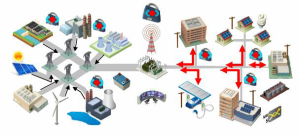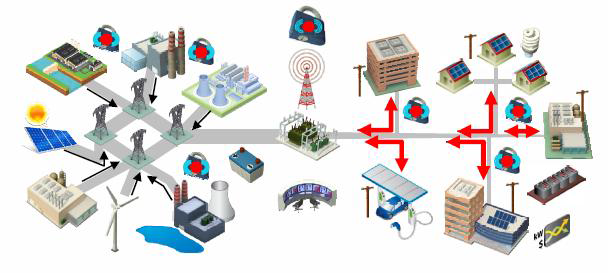The nation’s electric power system is central to the U.S. economy and our growing need for clean, reliable, and secure electric power. Yet today’s electric grid is under increasing pressure to change and modernize in the face of emerging challenges and technological opportunities.
Secretary of Energy Ernest Moniz announced the awards today as part of two new additions to DOE’s ongoing Grid Modernization Initiative. In total, the Secretary announced up to $220 million for 88 new projects across 14 National Laboratories to deliver new grid concepts, tools and technologies to support the nation’s effort to modernize the power grid. The Secretary also announced DOE’s comprehensive new Grid Modernization Multi-Year Program Plan, a blueprint for modernizing the grid.
 “The research in grid services and distribution system support tools will make the US Grid safer, more reliable and more resilient,” said Ramamoorthy Ramesh, Berkeley Lab’s Associate Lab Director for Energy Technologies. “We are honored to assist DOE by leading the California Distributed Resource Planning and Optimization Platform, also known as the California Regional Initiative, the Grid Modernization effort on Future Utility Regulation, and in supporting our colleagues across a number of different research projects designed to deliver technology solutions at scale.”
“The research in grid services and distribution system support tools will make the US Grid safer, more reliable and more resilient,” said Ramamoorthy Ramesh, Berkeley Lab’s Associate Lab Director for Energy Technologies. “We are honored to assist DOE by leading the California Distributed Resource Planning and Optimization Platform, also known as the California Regional Initiative, the Grid Modernization effort on Future Utility Regulation, and in supporting our colleagues across a number of different research projects designed to deliver technology solutions at scale.”
“We are pleased to see DOE fund Berkeley Lab to lead the California multi-lab proposal for optimizing distributed energy resources,” said California Energy Commission Chair Robert B. Weisenmiller. “This is incredibly important given California’s efforts to transform its electric system and meet the state’s greenhouse gas reduction goals.”
This past year, DOE coordinated the first of many Quadrennial Energy Reviews for the White House, examining the nation’s energy situation and priorities across all federal agencies. A key finding was the need for a modern electric grid capable of handling increasing loads while being flexible enough to incorporate rapid market changes and emerging technologies. Critical factors related to this challenge included regulatory and planning hurdles, funding for technology development and stakeholder engagement, and federal and industry technical standards.
In response to the QER, DOE asked the national laboratories to create a coordinated mechanism for delivering R&D and working with industry to deploy new concepts to make the grid cleaner, more productive, and more secure. As a result, the Grid Modernization Laboratory Consortium was formed in November 2014, representing the coordinated capabilities of 14 DOE national laboratories.
Today’s announcement by DOE is a key milestone for the Grid Modernization Initiative, launching the steps outlined in DOE’s newly released Multi-Year Program Plan, and implemented through the subsequent project proposals developed with the Laboratory consortium, universities and industry.
Projects led by Lawrence Berkeley National Lab include:
- Future Electric Utility Regulation. Berkeley Lab will lead a multi-year activity to develop and enhance utility financial analysis tools to provide analysis and technical assistance to state regulators that are considering incremental and more fundamental changes to utility regulatory and business models. Other labs involved in this project include: Los Alamos, National Energy Technology Lab, National Renewable Energy Lab, Pacific Northwest and Sandia National Laboratories. Also partnering in the project is the National Association of Regulatory Utility Commissioners.
- Distributed Energy Resource Siting and Optimization Tool to enable large-scale deployment of DER in California. Berkeley Lab will lead a multi-lab team (including Lawrence Livermore National Laboratory and SLAC National Accelerator Laboratory) that will deliver to the California Public Utilities Commission, investor-owned utilities and stakeholders an integrated distributed resource planning and optimization platform, hosted online, and able to identify meaningful behind-the-meter DER adoption patterns, potential microgrid sites and demand-side resources, and evaluate the impacts of high renewable penetration feeders on the distribution and transmission grid.
Berkeley Lab will also contribute to multi-lab teams in grid modernization R&D projects in the following areas: (1) Grid Services and Technology Valuation Framework, 2) Distribution System Decision Support Tool Development and Application, (3) Standards and Test Procedures for Interconnection and Interoperability, (4) Establishment of a multi-lab Testing Network, (5) Development of definitions, standards and test procedures for grid services, and (6) Development of detection and response techniques for threats to security and resilience.
For a full list of the projects and their proposed funding, go here.
# # #
Lawrence Berkeley National Laboratory addresses the world’s most urgent scientific challenges by advancing sustainable energy, protecting human health, creating new materials, and revealing the origin and fate of the universe. Founded in 1931, Berkeley Lab’s scientific expertise has been recognized with 13 Nobel prizes. The University of California manages Berkeley Lab for the U.S. Department of Energy’s Office of Science. For more, visit www.lbl.gov.
DOE’s Office of Science is the single largest supporter of basic research in the physical sciences in the United States, and is working to address some of the most pressing challenges of our time. For more information, please visit science.energy.gov.
